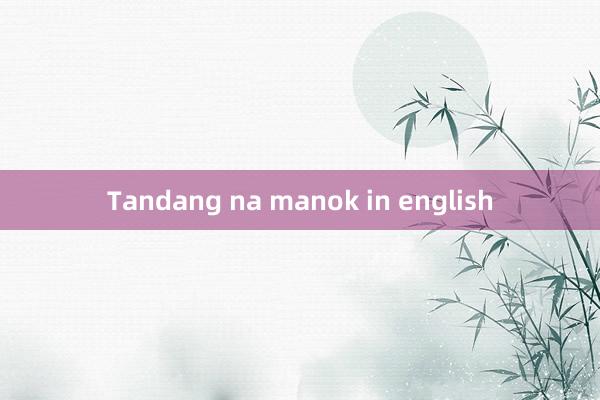Tandang na manok in english

Tandang na Manok in English: Understanding the "Rooster" and Its Cultural Significance
In English, the Filipino phrase "Tandang na Manok" directly translates to “Rooster” or “Old Rooster.” Beyond this basic translation, however, the term carries deeper cultural meanings within the Philippines and in many other parts of the world. This article will explore what the rooster symbolizes, its role in daily life and cultural traditions, and how it has become an enduring icon in both rural and urban settings.
The Role of the Rooster in Daily Life
Roosters are often associated with rural life, particularly in farming communities, where they serve as reliable morning alarm clocks. Their crowing at the break of dawn signals the start of the day, helping farmers manage their schedules. In the Philippines, many households, especially in provinces, keep roosters in their backyards not only for their utility but also for their aesthetic and symbolic value.
In many cultures, roosters represent time, routine, and discipline. Their natural behavior of crowing at sunrise creates a sense of structure, reminding people of the importance of rising early and starting the day with purpose. This rhythm is deeply ingrained in the life of many Filipinos, who follow a schedule closely tied to the natural environment.
The Cultural Significance of the Tandang na Manok
Beyond its practical role, the rooster holds cultural importance. In Filipino tradition, the rooster is often seen as a symbol of masculinity, courage, and leadership. A "tandang" (an older, mature rooster) is commonly regarded as the leader among other chickens, embodying strength and dominance. This is why, metaphorically, the term "tandang" is sometimes used to describe older men who still exhibit energy, leadership, and vitality, much like a seasoned fighter.
Roosters are also deeply associated with Filipino celebrations and festivals. During traditional gatherings, such as fiestas, you may notice roosters being part of parades or events, symbolizing good fortune and prosperity. In some regions, owning a healthy and well-cared-for rooster is seen as a source of pride, reflecting a family's wealth and status in the community.
Cockfighting: A Controversial Tradition
One of the most well-known traditions connected to the rooster in the Philippines is sabong, or cockfighting. This practice, though controversial, has been deeply rooted in Filipino culture for centuries. It involves two roosters, often specially bred and trained, engaging in a fight while spectators place bets.
Cockfighting, while entertaining for many, is viewed differently by various groups. Some regard it as a cultural heritage that brings communities together and offers an opportunity for social bonding. Others, particularly animal rights activists, criticize it for being cruel to the animals involved. Regardless of perspective, sabong reflects the prominence of roosters in Filipino life—not just as farm animals but as participants in long-standing traditions.
tải go88Roosters in Global Symbolism
The symbolism of the rooster extends beyond the Philippines. In various parts of the world, it represents themes like vigilance, courage, and renewal. In Chinese culture, the rooster is one of the twelve zodiac animals, symbolizing punctuality, loyalty, and hard work. Similarly, in European folklore, the crowing of a rooster at dawn is said to ward off evil spirits.
In Christian tradition, the rooster holds a unique place as well. It appears in the Bible, specifically in the story of Peter’s denial of Jesus, where a rooster’s crow serves as a reminder of human weakness and the need for repentance. In this sense, the rooster functions as a spiritual symbol, encouraging believers to stay vigilant and self-aware.
Modern Depictions and Use of the Rooster
Today, roosters continue to serve as decorative symbols in both rural and urban settings. From garden ornaments to colorful illustrations in art and home décor, the rooster evokes feelings of nostalgia and appreciation for traditional values. In Filipino homes, rooster-inspired sculptures or images often find their place, connecting modern households with ancestral roots.
Additionally, the rooster has become a branding icon for various businesses, especially in the food and restaurant industry. Many Filipino eateries use roosters in their logos, subtly reflecting the animal’s connection to fresh, local ingredients and rural life. The rooster’s vibrant colors and energetic posture also make it an attractive emblem for promoting a lively and welcoming atmosphere.
Conclusion
The phrase “Tandang na Manok” may translate simply to “rooster” in English, but the meaning behind it runs deeper. Roosters are more than just farm animals—they represent structure, leadership, and cultural heritage. In the Philippines, the rooster has become a familiar companion in daily life, a symbol of masculinity and courage, and a centerpiece of traditional celebrations like sabong.
Understanding the role and symbolism of the rooster helps one appreciate its significance not only in Filipino culture but also in global traditions. Whether it’s waking people up at dawn or serving as a metaphor for resilience, the rooster stands as a timeless symbol that continues to inspire respect and admiration around the world.
jili apps legitwww.911hits.com

